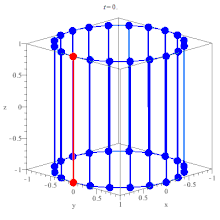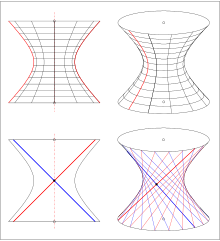Hyperboloid (original) (raw)
From Wikipedia, the free encyclopedia
Unbounded quadric surface
In geometry, a hyperboloid of revolution, sometimes called a circular hyperboloid, is the surface generated by rotating a hyperbola around one of its principal axes. A hyperboloid is the surface obtained from a hyperboloid of revolution by deforming it by means of directional scalings, or more generally, of an affine transformation.
A hyperboloid is a quadric surface, that is, a surface defined as the zero set of a polynomial of degree two in three variables. Among quadric surfaces, a hyperboloid is characterized by not being a cone or a cylinder, having a center of symmetry, and intersecting many planes into hyperbolas. A hyperboloid has three pairwise perpendicular axes of symmetry, and three pairwise perpendicular planes of symmetry.
Given a hyperboloid, one can choose a Cartesian coordinate system such that the hyperboloid is defined by one of the following equations: x 2 a 2 + y 2 b 2 − z 2 c 2 = 1 , {\displaystyle {x^{2} \over a^{2}}+{y^{2} \over b^{2}}-{z^{2} \over c^{2}}=1,} 


One has a hyperboloid of revolution if and only if a 2 = b 2 . {\displaystyle a^{2}=b^{2}.} 
There are two kinds of hyperboloids. In the first case (+1 in the right-hand side of the equation): a one-sheet hyperboloid, also called a hyperbolic hyperboloid. It is a connected surface, which has a negative Gaussian curvature at every point. This implies near every point the intersection of the hyperboloid and its tangent plane at the point consists of two branches of curve that have distinct tangents at the point. In the case of the one-sheet hyperboloid, these branches of curves are lines and thus the one-sheet hyperboloid is a doubly ruled surface.
In the second case (−1 in the right-hand side of the equation): a two-sheet hyperboloid, also called an elliptic hyperboloid. The surface has two connected components and a positive Gaussian curvature at every point. The surface is convex in the sense that the tangent plane at every point intersects the surface only in this point.
Parametric representations
[edit]
Animation of a hyperboloid of revolution
Cartesian coordinates for the hyperboloids can be defined, similar to spherical coordinates, keeping the azimuth angle θ ∈ [0, 2_π_), but changing inclination _v_ into hyperbolic trigonometric functions:
One-surface hyperboloid: v ∈ (−∞, ∞) x = a cosh v cos θ y = b cosh v sin θ z = c sinh v {\displaystyle {\begin{aligned}x&=a\cosh v\cos \theta \\y&=b\cosh v\sin \theta \\z&=c\sinh v\end{aligned}}} 
Two-surface hyperboloid: v ∈ [0, ∞) x = a sinh v cos θ y = b sinh v sin θ z = ± c cosh v {\displaystyle {\begin{aligned}x&=a\sinh v\cos \theta \\y&=b\sinh v\sin \theta \\z&=\pm c\cosh v\end{aligned}}} 
hyperboloid of one sheet: generation by a rotating hyperbola (top) and line (bottom: red or blue)
hyperboloid of one sheet: plane sections
The following parametric representation includes hyperboloids of one sheet, two sheets, and their common boundary cone, each with the z {\displaystyle z} 

- For d > 0 {\displaystyle d>0}
one obtains a hyperboloid of one sheet,
- For d < 0 {\displaystyle d<0}
a hyperboloid of two sheets, and
- For d = 0 {\displaystyle d=0}
a double cone.
One can obtain a parametric representation of a hyperboloid with a different coordinate axis as the axis of symmetry by shuffling the position of the c s {\displaystyle cs} 
Generalised equations
[edit]
More generally, an arbitrarily oriented hyperboloid, centered at v, is defined by the equation ( x − v ) T A ( x − v ) = 1 , {\displaystyle (\mathbf {x} -\mathbf {v} )^{\mathrm {T} }A(\mathbf {x} -\mathbf {v} )=1,} 
The eigenvectors of A define the principal directions of the hyperboloid and the eigenvalues of A are the reciprocals of the squares of the semi-axes: 1 / a 2 {\displaystyle {1/a^{2}}} 


Hyperboloid of one sheet
[edit]
Lines on the surface
[edit]
- A hyperboloid of one sheet contains two pencils of lines. It is a doubly ruled surface.
If the hyperboloid has the equation x 2 a 2 + y 2 b 2 − z 2 c 2 = 1 {\displaystyle {x^{2} \over a^{2}}+{y^{2} \over b^{2}}-{z^{2} \over c^{2}}=1} 
g α ± : x ( t ) = ( a cos α b sin α 0 ) + t ⋅ ( − a sin α b cos α ± c ) , t ∈ R , 0 ≤ α ≤ 2 π {\displaystyle g_{\alpha }^{\pm }:\mathbf {x} (t)={\begin{pmatrix}a\cos \alpha \\b\sin \alpha \\0\end{pmatrix}}+t\cdot {\begin{pmatrix}-a\sin \alpha \\b\cos \alpha \\\pm c\end{pmatrix}}\ ,\quad t\in \mathbb {R} ,\ 0\leq \alpha \leq 2\pi \ } 
In case a = b {\displaystyle a=b} 


A hyperboloid of one sheet is projectively equivalent to a hyperbolic paraboloid.
For simplicity the plane sections of the unit hyperboloid with equation H 1 : x 2 + y 2 − z 2 = 1 {\displaystyle \ H_{1}:x^{2}+y^{2}-z^{2}=1} 
Obviously, any one-sheet hyperboloid of revolution contains circles. This is also true, but less obvious, in the general case (see circular section).
Hyperboloid of two sheets
[edit]
hyperboloid of two sheets: generation by rotating a hyperbola
hyperboloid of two sheets: plane sections
The hyperboloid of two sheets does not contain lines. The discussion of plane sections can be performed for the unit hyperboloid of two sheets with equation H 2 : x 2 + y 2 − z 2 = − 1. {\displaystyle H_{2}:\ x^{2}+y^{2}-z^{2}=-1.} 
Obviously, any two-sheet hyperboloid of revolution contains circles. This is also true, but less obvious, in the general case (see circular section).
Remark: A hyperboloid of two sheets is projectively equivalent to a sphere.
The hyperboloids with equations x 2 a 2 + y 2 b 2 − z 2 c 2 = 1 , x 2 a 2 + y 2 b 2 − z 2 c 2 = − 1 {\displaystyle {\frac {x^{2}}{a^{2}}}+{\frac {y^{2}}{b^{2}}}-{\frac {z^{2}}{c^{2}}}=1,\quad {\frac {x^{2}}{a^{2}}}+{\frac {y^{2}}{b^{2}}}-{\frac {z^{2}}{c^{2}}}=-1} 
- pointsymmetric to the origin,
- symmetric to the coordinate planes and
- rotational symmetric to the z-axis and symmetric to any plane containing the z-axis, in case of a = b {\displaystyle a=b}
(hyperboloid of revolution).
Whereas the Gaussian curvature of a hyperboloid of one sheet is negative, that of a two-sheet hyperboloid is positive. In spite of its positive curvature, the hyperboloid of two sheets with another suitably chosen metric can also be used as a model for hyperbolic geometry.
In more than three dimensions
[edit]
Imaginary hyperboloids are frequently found in mathematics of higher dimensions. For example, in a pseudo-Euclidean space one has the use of a quadratic form: q ( x ) = ( x 1 2 + ⋯ + x k 2 ) − ( x k + 1 2 + ⋯ + x n 2 ) , k < n . {\displaystyle q(x)=\left(x_{1}^{2}+\cdots +x_{k}^{2}\right)-\left(x_{k+1}^{2}+\cdots +x_{n}^{2}\right),\quad k<n.} 

As an example, consider the following passage:[4]
... the velocity vectors always lie on a surface which Minkowski calls a four-dimensional hyperboloid since, expressed in terms of purely real coordinates (_y_1, ..., _y_4), its equation is _y_2
1 + _y_2
2 + _y_2
3 − _y_2
4 = −1, analogous to the hyperboloid _y_2
1 + _y_2
2 − _y_2
3 = −1 of three-dimensional space.[6]
However, the term quasi-sphere is also used in this context since the sphere and hyperboloid have some commonality (See § Relation to the sphere below).
Hyperboloid structures
[edit]
One-sheeted hyperboloids are used in construction, with the structures called hyperboloid structures. A hyperboloid is a doubly ruled surface; thus, it can be built with straight steel beams, producing a strong structure at a lower cost than other methods. Examples include cooling towers, especially of power stations, and many other structures.
- Gallery of one sheet hyperboloid structures









The THTR-300 cooling tower for the now decommissioned thorium nuclear reactor in Hamm-Uentrop, Germany, 1983.

The Killesberg observation tower, Stuttgart, Germany, 2001.
BMW Welt, (BMW World), museum and event venue, Munich, Germany, 2007.
Relation to the sphere
[edit]
In 1853 William Rowan Hamilton published his Lectures on Quaternions which included presentation of biquaternions. The following passage from page 673 shows how Hamilton uses biquaternion algebra and vectors from quaternions to produce hyperboloids from the equation of a sphere:
... the equation of the unit sphere _ρ_2 + 1 = 0, and change the vector ρ to a bivector form, such as σ + τ √−1. The equation of the sphere then breaks up into the system of the two following,
_σ_2 − _τ_2 + 1 = 0, S.στ = 0;
and suggests our considering σ and τ as two real and rectangular vectors, such that
Tτ = (T_σ_2 − 1 )1/2.
Hence it is easy to infer that if we assume σ || λ, where λ is a vector in a given position, the new real vector σ + τ will terminate on the surface of a double-sheeted and equilateral hyperboloid; and that if, on the other hand, we assume τ || λ, then the locus of the extremity of the real vector σ + τ will be an equilateral but single-sheeted hyperboloid. The study of these two hyperboloids is, therefore, in this way connected very simply, through biquaternions, with the study of the sphere; ...
In this passage S is the operator giving the scalar part of a quaternion, and T is the "tensor", now called norm, of a quaternion.
A modern view of the unification of the sphere and hyperboloid uses the idea of a conic section as a slice of a quadratic form. Instead of a conical surface, one requires conical hypersurfaces in four-dimensional space with points p = (w, x, y, z) ∈ R4 determined by quadratic forms. First consider the conical hypersurface
Then P ∩ H r {\displaystyle P\cap H_{r}} 
Q = { p : w 2 + z 2 = x 2 + y 2 } {\displaystyle Q=\lbrace p\ :\ w^{2}+z^{2}=x^{2}+y^{2}\rbrace } 

In the theory of quadratic forms, a unit quasi-sphere is the subset of a quadratic space X consisting of the x ∈ X such that the quadratic norm of x is one.[7]
Shukhov hyperboloid tower (1898) in Vyksa, Russia
- De Sitter space
- Ellipsoid
- List of surfaces
- Paraboloid / Hyperbolic paraboloid
- Regulus
- Rotation of axes
- Split-quaternion § Profile
- Translation of axes
- ^ K. Strubecker: Vorlesungen der Darstellenden Geometrie. Vandenhoeck & Ruprecht, Göttingen 1967, p. 218
- ^ CDKG: Computerunterstützte Darstellende und Konstruktive Geometrie (TU Darmstadt) (PDF; 3,4 MB), S. 116
- ^ CDKG: Computerunterstützte Darstellende und Konstruktive Geometrie (TU Darmstadt) (PDF; 3,4 MB), S. 122
- ^ Thomas Hawkins (2000) Emergence of the Theory of Lie Groups: an essay in the history of mathematics, 1869—1926, §9.3 "The Mathematization of Physics at Göttingen", see page 340, Springer ISBN 0-387-98963-3
- ^ Walter, Scott A. (1999), "The non-Euclidean style of Minkowskian relativity", in J. Gray (ed.), The Symbolic Universe: Geometry and Physics 1890-1930, Oxford University Press, pp. 91–127
- ^ Minkowski used the term "four-dimensional hyperboloid" only once, in a posthumously-published typescript and this was non-standard usage, as Minkowski's hyperboloid is a three-dimensional submanifold of a four-dimensional Minkowski space M 4 . {\displaystyle M^{4}.}
[5]
- ^ Ian R. Porteous (1995) Clifford Algebras and the Classical Groups, pages 22, 24 & 106, Cambridge University Press ISBN 0-521-55177-3
- Wilhelm Blaschke (1948) Analytische Geometrie, Kapital V: "Quadriken", Wolfenbutteler Verlagsanstalt.
- David A. Brannan, M. F. Esplen, & Jeremy J Gray (1999) Geometry, pp. 39–41 Cambridge University Press.
- H. S. M. Coxeter (1961) Introduction to Geometry, p. 130, John Wiley & Sons.

Look up hyperboloid in Wiktionary, the free dictionary.







